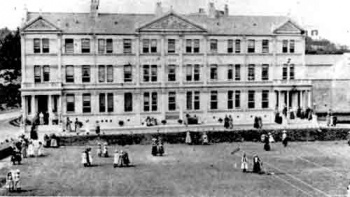Having started to catch up with standards in the United Kingdom after all primary schools were brought under States control in 1913, Jersey's education system rapidly went downhill because the States refused to build any new schools to meet the demand they had created by introducing compulsory education between the ages of five and twelve.
Overcrowding
Existing schools were out of date and drastically overcrowded, yet between the two world wars Grouville Elementary School was the only new building provided by the States. Successive HM Inspectors of Education drew attention to the problem, which was most serious in St Helier, but the States did nothing. And this was despite receiving a report in 1925 which indicated that 102 girls in five classes were being taught in a single room at St James School.
To meet the demand which was not being satisfied by the 38 elementary schools under States control, private schools began to spring up, as they had a century earlier, before the States took on responsibility for education. In 1925 there were 55 fee-paying private schools offering various standards of elementary education. But although parents were prepared to pay to give their children a better education than the States schools were providing, few actually achieved this objective.
In December 1925 HM Inspector reported to the States:"I have now visited 33 of these private schools educating some 1,500 children (at this time there were 4,173 children in States elementary schools). Of the remainder, a few, in which a comparatively high fee is charged, are satisfactorily taught and equipped. The majority fall considerably below the standard of the States Public ELementary Schools in staff, premises or equipment, if not in all three. That so many parents are found willing to pay fees to send their children to these schools, and in many cases to keep them there considerably beyond the age of compulsory school attendeance is I think a clear indication that there is a demand for something more than the public elementary school professes to supply. For some educational facilities intermediate between those afforded on the one hand by the public elementary schools and on the other by the two Colleges. The private schools profess to meet this demand but in most cases are unable to provide adequate staff, premises and equipment. Nor is the demand likely to be satisfactorily met, unless the committee undertakes to provide it."
New committee
The States had not been unwilling to take on responsibility for all aspects of education; they had just been unwilling to provide the money to do it properly. Five years before this damning HMI report, a new Education Act had been passed and a committee named Comité d'Instruction Publique had assumed responsibility not only for primary schools but for Victoria College, a secondary school for girls, technical instruction, teacher training, medical and dental treatment of children and a special school for the handicapped.
The administration of the 1920 law was supposed to be in the hands of a Director of Education with a fully staffed department, but it was to be 1953 before the first fully qualified Director was appointed.
As Senator John Le Marquand, who took on political responsibility for education in the 1950s wrote in 1997 in the second of three articles for the Annual Bulletin of La Société Jersiaise:
- "Evidence abounds that the States failed dismally and disgracefully to fulfil the promises set out so clearly and forthrightly in the law. Nothing whatsoever was done to alleviate the unacceptable overcrowding in urban elementary schools, mainly caused by the building of many small houses at Saint Luke, First Tower and Saint Clement.
- "In 1937, seventeen years after the registration of the 1920 Law, the Comité d'Instruction Publique repoorted to the States the distressing conditions in many schools and recommended that the Finance Committee be charged to privide the necessary legislation for a Loan Bill not exceeding £200,000 for the purpose of tackling some of the problems. The 1937 report described the conditions at St Luke's School as deplorable and Clearview Street School, a building that had been condemned, was reoccupied. HM Inspectors had persistently stressed the need for a new secondary school to accommodate the intermediate, thereby releasing modern classrooms for the children from Clearview Street and Saint Mark's Elementary Schools. However, stalemate continued.""
Although the States had acquired the Jersey College for Girls in 1935 in an attempt to bring secondary education for girls up to the standard available for boys at Victoria College, little progress had been made to bring overall standards of primary or secondary education up to a standard equivalent to that found in the United Kingdom when the German Occupation brought any progress to a total standstill after many of the island's children had been evacuated to England.
After the war, with every aspect of the island's administration under scrutiny by a new breed of politicians, dramatic changes in education provision were expected, but the plans put forward in 1947 were not dramatic enough for John Le Marquand.


